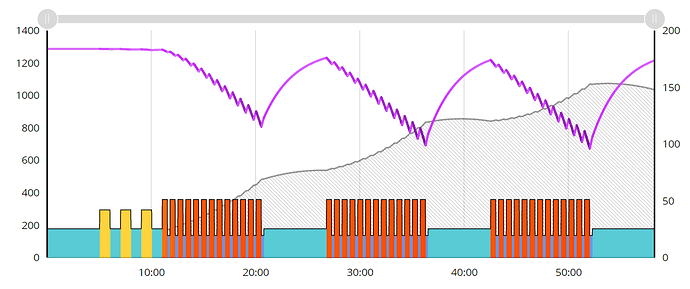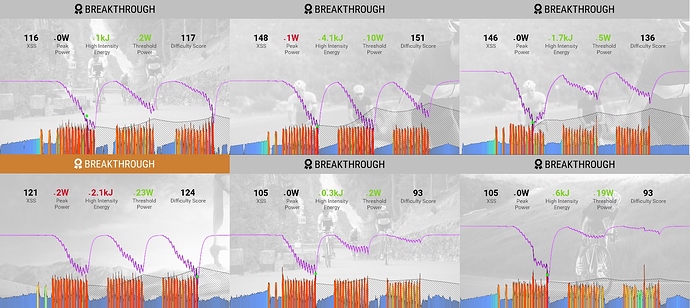My brief understanding of the xert program is that one needs volume to bring up TP, volume is best achieved by riding at around LTP (for fast recovery). Efforts at 2-3x FTP, tend to bring up HIE, and efforts closer to peak tend to bring up PP. Bringing up HIE/PP lowers TP somewhat, so its a bit of a trade. It also happens very quickly, and requires relatively little training. So it’s best to spend lots of time at around LTP, then do some shorter more intense training closer to the target date. This seems to reflect my experience. I’m sure there is a lot more to it, but hopefully I’m not completely wrong on this.
However, riding at around LTP seems to condition me mentally to accept LTP as some kind of upper limit. In the past I noticed that doing a few rides of about an hour at all out effort seemed beneficial from the “getting used to the pain” stand point. Is there anything to this? Would doing exercises that maximize difficulty help psychological adaptation and thus bring the real numbers closer to theoretical max?
You have an excellent basic understanding of how training affects your fitness. As far as psychology, Xert does capture this with the “difficulty” metric. In general, what you’ll notice is that athletes with a higher training load tend to be able to handle higher difficulty scores than newer or less trained athletes. However, even among well-trained athletes, the ability to suffer can vary greatly. Our sports physiologist Dr. Stephen Cheung wrote an article on this for Pez cycling not too long ago…check it out here: https://www.pezcyclingnews.com/toolbox/cycling-fitness-and-repeatability/
Scott, thank you. I believe Dr Cheung describes the same problem I am, but I’m not too clear as to what remedy he proposes? Is it doing exercises like the CX - Ronnestad, or is it simply a matter of raising the training load?
Fox example last weekend, I did a century ride. I settled on an easy pace of about 1/2 Threshold Power. Since the ride was long, the XSS score was pretty high, 295. If I did these more often, I’d expect my training load to increase (most of my rides have an XSS score of about 100). Will this make it “easier” to stay at potential, or do I need to focus on these high intensity workouts?
Scott
From the article,concerning “I do them with the ergometer on free mode (i.e., I determine intensity rather than the trainer requiring a specific wattage). Or else I do them riding in Zwift on the flattest course possible so that I don’t suddenly get slammed by a 10% wall or spinning out downhill.”
How do you follow this workout in these 2 examples,if not in ERG?
Here is an example of a Ronnestad session that I did in slope mode. The warmup I did in ERG mode with a High Intensity Warmup that I designed for sessions like the following. After the warmup, I switched the ergometer into slope mode… the hard intervals were done at 4% slope, 30s big ring, 15s small ring. Rest between intervals was done 2% slope, small ring until MPA recovered. Doing this workout in slope mode results in steady, predictable resistance where I can push as hard as I’d like (or back off a bit if needed). HTH
Thanks Scott
Ok. How are you following the timing of the intervals?
I take it you are creating the power demands by manually adjusting slope during the workout?
EIther follow the workout in Xert and see the interval time via remote player or use an interval timer app that dings every 30s during an interval and 15s between. Either works fine.
The workout was done in slope mode. The warmup/easy recovery between sets was set to ~2% slope, while the slope during the tabata-style efforts was set to 4%. Controlling the power within the tabata’s was accomplished by using big ring for ‘ON’ and small ring for ‘RECOVER’
Hope this helps! Play around with it yourself and see how it goes!
The topic shifts a bit towards how to perform the Ronnestad workout, but I’m curious too about how to approach training for this difficulty/repeated efforts.
Next to that. For my fitness signature the Ronnestad workout does not completely bring down MPA. What would be a good way to adjust it?
Why not do the Ronnestad workout in the library - if that brings down MPA then base your version on that one.
To get good at short bursts you need to train at high intensity for short periods of time.
In case I haven’t hammered it home enough in the podcasts, I highly recommend doing this workout in SLOPE mode (set slope to 2.0%) and control the effort yourself. You can use the power targets as a guide, but being able to directly control the effort will allow you to guarantee that you can push all the way for a BT.
The first time you do it will likely be a learning experience (learning how to pace it, which gears/cadence to use, etc.), but I promise that you won’t want to go back to doing this in ERG mode. I did this workout with several others a week ago (all of us were doing it in SLOPE mode), and look at the results:


